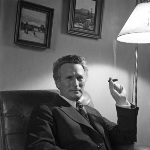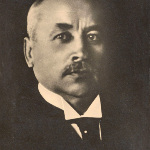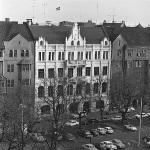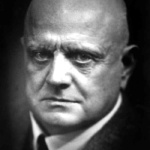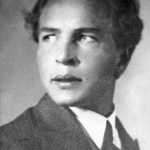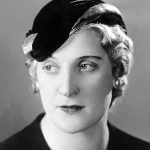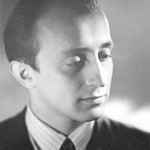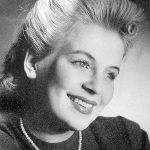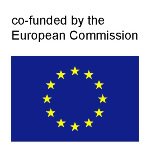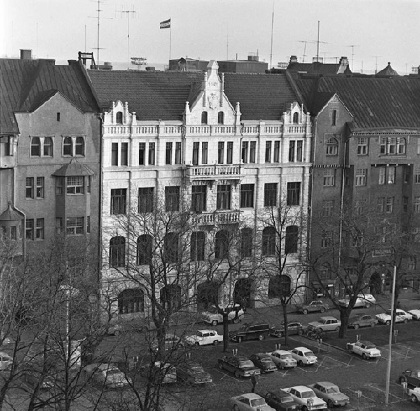
Songs
- 1 Suvilaulu (Yrjö Kilpinen)
- 2 Sinikan laulu (Toivo Kuula)
- 3 Tule tuulantei (Oskar Merikanto)
- 4 Laula tyttö (Oskar Merikanto)
- 5 Svarta rosor (Jean Sibelius)
- 6 Nuoruus (Erkki Melartin)
- 7 Merellä (Oskar Merikanto)
- 8 Torkkelin muistoja (George de Godzinsky)
- 9 Scene from opera
- 10 Onnelliset (Oskar Merikanto)
- artist:Various Artists
- featured artist:Aulikki RAUTAWAARA, Tii NIEMELÄ, Maiju KUUSOJA, Maria HEIDI, Marja TYRKKÖ, Liisa LINKO-MALMIO, Lea PILTTI, ....
- release year:2008
- country:Finland
- formats:Audio File / Digital
- record posted by:Tero Halvorsen
Links
This CD project is the first of four audio compilations created in the framework of DISMARC (Discovering Music Archives), co-funded by the European Commission. The project consists of 28 songs, several photos and a detailed booklet.
The sound archives of Yleisradio (YLE) are the most important source for the study of mid-20th century Finnish singers. Yleisradio, the Finnish Broadcasting Company was founded in 1926. At first, all broadcasts were live, and the performers had to travel to the studios at the time of the broadcast. In 1935 the company bought a disc cutter, which made the archiving of programs on 78rpm discs possible. It was now possible to record radio programs in advance, at a time most suitable for the performers - if the performance was successful, the broadcast was repeated. The first tape recorders arrived in 1939 but, for more than a decade, tape and disc were used in parallel. Tape became the standard method of archiving radio programs in the 1950s.
Professional-quality magnetic tape was initially very expensive. To save costs, tapes were recycled. Once a program had been broadcast, tapes were erased and used to record new programs. For this reason, relatively few complete radio programs survive from the period before 1955, and the surviving tapes have been poorly documented.
In the 1950s, radio stations the world over increasingly began to use records in their broadcasts. Commercial recordings of Finnish classical music had been made regularly since early 20th century, but after the Second World War, local record companies focused almost exclusively on popular music. There were practically no new recordings of Finnish serious music. In 1954, Yleisradio's music department initiated a policy of systematically recording the best singers and musicians in the country, to obtain material for broadcasts. The artists were paid a higher fee in return for perpetual broadcasting rights. The recordings were archived as single tracks and used in radio programs like commercial recordings. The practice still continues and, by the year 2000, more than 15,000 tracks of music had been recorded. These music recordings ("kantanauha" in Finnish) are an important source for information about Finnish singers and musicians. Today they are all catalogued and digitised, and details of the recordings can be found in the Dismarc database.
The purpose of this CD is to offer a representative selection of Finnish singers of the 1950s performing songs by Finnish composers. The artists chosen are the best-known singers of the period, but many never made commercial recordings, or merely recorded 'light' music not representative of their talents. Most of the singers had their golden decade in the 1950s, but we have also included Lea Piltti, Irja Aholainen, Aulikki Rautawaara and Aune Antti, whose peak years were before the war, because they were nonetheless respected figures in their field during the Fifties. Two major singers of the decade, Egnar Holmström and Lasse Wager have been omitted, because no recordings of their performances survive at the YLE archives.
Because of the limitations of the Compact Disc, we have had to limit the number of singers to 30. Among the artists not included here we should mention at least Vera Froloff, Auvo Nuotio, Sulo Saarits, Inkeri Rantasalo, Greta Fougstedt, Pirkko Siirilä, Ami Lovén and Anneli Aarika - all respected singers who were frequently heard on Finnish radio in the 1950s. We have also excluded Anita Välkki, Raili Kostia, Irma Urrila, Ilona Koivisto, Marja Eskola, Usko Viitanen, Matti Tuloisela and Pekka Nuotio. Although they made their debuts in the 1950s, they belong to the following decades in the history of Finnish singing.
Yleisradio's annual report 1954 suggests that the amount of program time devoted to vocal music was relatively small. "Large-scale musical works" and operettas constituted 1.4 per cent of program time. Chamber music was assigned 1.2 %, dramatic music 0.6 %, symphonic music 5.1 %, other concert music 19.3 %, folk music 2.7 %, popular music 31 %, light music 33.8 and dance music 4.9 %. These figures do not tell the complete truth. In the 1950s, commercial recordings did not dominate radio programming as they do today. Especially in the field of serious music, most programs were original productions, either live concerts or studio productions. A week's program schedule typically included two to four 15-20 minute recitals with Finnish singers, usually with piano accompaniment. In the course of a year, dozens of singers presented their own recitals on the airwaves.
The programs were usually titled simply "Matti Lehtinen sings" or "Jolly melodies. Pentti Tuominen, accompanied by Mikko von Deringer". Some programs were collections of miscellaneous songs, others focused on specific themes such as the works of a single composer or a poet. In addition to recitals, Yleisradio broadcast one or two studio operas or operettas every year and transmitted a number of live concerts. Songs or arias with orchestral accompaniment were seldom produced in the studios, and listeners could only enjoy them in connection with live concerts. Most of the titles on this CD with orchestral accompaniment are excerpts from such recordings. The opera "Mare ja hänen poikansa", by Tauno Pylkkänen, was an abbreviated studio production.
The range of compositions presented in radio programs was quite broad, but the emphasis was on Finnish music. The core repertoire consisted of older works by Sibelius, Merikanto, Kilpinen, Kuula, Palmgren, Melartin and Madetoja, but the music of contemporary composers such as Tauno Pylkkänen, Erik Bergman, Aarre Merikanto, Ernst Linko and Sulho Ranta was also regularly presented. 19th century composers like Karl Collan and Fredrik Pacius also had an important role in the song repertoire in the 1950s, because they had set to music the texts of Johan Ludvig Runeberg and Zachris Topelius, the principal Finnish poets of the century. Their patriotic poems (originally written in Swedish and translated into Finnish) were still part of the school curriculum in the 1950s, as they were considered important parts of national heritage.
Jean Sibelius had died in 1957 at the age of 91 years. He was buried with ceremonies usually reserved for heads of state. In the 1950s, all other Finnish composers lived in his shadow. In practice, however, the songs of his contemporary Oskar Merikanto (1868-1924) were better known in Finnish homes. Merikanto's melodies have retained their popularity to the present day, and this collection includes several of his best-known works.
Another important song composer of the era was Toivo Kuula (1883-1918), who tragically lost his life in the aftermath of the Finnish civil war. The popularity of Merikanto and Kuula was in part based on the fact that they used poems written in Finnish, while Sibelius had still preferred poets writing in Swedish, his own mother tongue.
Besides Sibelius, Yrjö Kilpinen (1892-1959) was the only Finnish song composer to receive international acclaim in his day. An album of his Lieder, performed by Gerard Hüsch, had appeared in 1935 in the HMV "Society" series. Kilpinen was especially popular in Germany, and he returned the compliment by writing songs celebrating the German occupation of Norway and the Finnish SS battalion. This did not diminish his status in post-war Finland, and in the 1950s his music was still regularly broadcast.
George de Godzinsky (1914-1994) has sometimes been called the Franz Lehár of Finland. He was a brilliant pianist who once accompanied Chaliapin on his Far Eastern tour. He was also a conductor and arranger and led the Finnish Radio Light Music Orchestra in the 1950s. Most of the singers heard on this CD worked at various times with him. His compositions belong to the area between classical and light music.
In addition to the singers, this collection presents several important Finnish pianists and conductors of the decade. Gerda Weneskoski (1892-1984) was Yleisradio's legendary staff pianist from 1928 to 1957. During this period she was accompanied most of the singers performing on the radio. After Weneskoski, Pentti Koskimies (1922-1990) was the most frequently used accompanists in the studios. He shared this task with Marja Oja, Irma Ruuskanen and Cyril Szalkiewicz. Mikko von Deringer specialized in lighter music, Rolf Bergroth was principally a soloist, Erik Bergman composer and Jouko Tolonen head of the national opera. Leo Funtek conducted the orchestra of the National opera, Tauno Hannikainen the Helsinki Symphony Orchestra. Nils-Erik Fougstedt was the regular conductor of the Finnish Radio Symphony Orchestra.
With the exception of the oldest track, all recordings were made on magnetic tape, which guarantees that they are technically superior to commercial disc recordings of the same period.
Complete tracklist:
- "Hymn to Thais" (Jean Sibelius); RAUTAWAARA, Aulikki; Radio Orchestra/Nils-Eric Fougstedt (1953)
- "Suvilaulu" (Yrjö Kilpinen); NIEMELÄ, Tii; Pentti Koskimies, piano (1954)
- "Nouse, ole kirkas" (Helvi Leiviskä); KUUSOJA, Maiju; Taneli Kuusisto, piano (1954)
- "Sinikan laulu" (Toivo Kuula); HEIDI, Maria; Jouko Tolonen, piano (1955)
- "Karjapihassa" (Toivo Kuula); TYRKKÖ, Marja; Helsinki Filharmonia/Tauno Hannikainen (1956)
- "Elokuun yö" (Ernst Linko); LINKO-MALMIO, Liisa; Irma Ruuskanen, piano (1954)
- "Rarahu" (Sulho Ranta); PILTTI, Lea; Cyril Szalkiewicz, piano (1954)
- "Tule tuulantei" (Oskar Merikanto); KOSKELA, Sinikka; Taneli Kuusisto, piano (1954)
- "Skymningen faller" (Erik Bergman); LÅNGHOLM, Sylvelin; Erik Bergman, piano (1954)
- "Exponsions (Tauno Pylkkänen); EIRA, Maaria; Radio Symphony Orchestra/Nils-Eric Fougstedt (1957)
- "Niin on meitä piikasia" (Yrjö Kilpinen); ANTTI, Aune; Margaret Kilpinen, piano (1950)
- "Laula tyttö" (Oskar Merikanto); MUTANEN, Anna; Marja Oja, piano (1957)
- "Kottarainen" (Oskar Merikanto); HELIN, Mirjam; Orchestra/Mikko von Deringer (1955)
- "Kas tuolla lentää haukka/The Ostrobothnians" (Leevi Madetoja); LAHTINEN, Lauri; Helsinki Filharmonia/Tauno Hannikainen (1957)
- "Svarta rosor" (Jean Sibelius); KOSKINEN, Antti; Pentti Koskimies, piano (1954)
- "Rauha" (Ilmari Hannikainen); LEHTINEN, Matti; Jouko Tolonen, piano (1956)
- "En latmansmelodi" (Selim Palmgren); IKONEN, Yrjö; Märtha Ikonen, piano (1956)
- "Nuoruus" (Erkki Melartin); ARA, Ture; Pentti Koskimies, piano (1956)
- "Si drömmaren kommer där" (Erik Bergman); HEIKKILÄ, Hannu; Rolf Bergroth, piano (1954)
- "Kosiovarsa" (Leevi Madetoja); VAINIO, Aarne; Cyril Szalkiewicz, piano (1957)
- "Laulu ristilukista" (Jean Sibelius); KÖYSTI, Gustaf; Grossen Orchester Berlin d.StRK/Otto Dobrindt (1953)
- "Merellä" (Oskar Merikanto); RUUSUNEN, Kalle; Irma Ruuskanen, piano (1956)
- "Kom nu hit, död" (Jean Sibelius); BORG, Kim; Radio Symphony Orchestra/Jussi Jalas (1957)
- "Hilu, hilu" (Finnish Traditional, arr. Sulho Ranta); HALLAPERÄ, Reino; Pentti Koskimies, piano (1954)
- "Soldatgossen" (Fredrik Pacius); EKLUND, Hemming; Gerda Weneskoski, piano (1955)
- "Torkkelin muistoja" (George de Godzinsky); KÄYHKÖ, Kauko; Radio Orchestra/George de Godzinsky (1957)
- Scene from opera "Mare and Her Son" (Tauno Pylkkänen); AHOLAINEN, Irja & HUTTUNEN, Jorma; Radio Orchestra/Leo Funtek (1953)
- "Onnelliset" (Oskar Merikanto); VILPPULA, Malmi & TYRVÄINEN, Veikko; Taneli Kuusisto, piano (1956)


